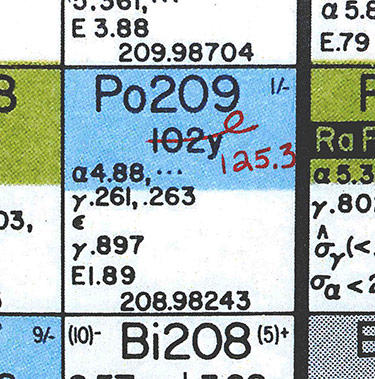Polonium's Most Stable Isotope Gets Revised Half-Life Measurement

Scientists at the National Institute of Standards and Technology (NIST) have determined* that polonium-209, the longest-lived isotope of this radioactive heavy element, has a half-life about 25 percent longer than the previously determined value, which had been in use for decades.
The new NIST measurements could affect geophysical studies such as the dating of sediment samples from ocean and lake floors. They often employ Po-209 as a tracer. Because sediment cores are used for determining human impact on the environment over the past century, the new measurement could impact these studies as well as other environmental measurements and biological assays.
Polonium has more than 30 isotopes, all of them radioactive and highly poisonous. The difficulty in measuring the particular Po-209 half-life arises from its scarcity in pure form, the long length of its half-life, and the specific types of radiation involved in its decay. The widely used value for Po-209 dates from 1956. Decades later, NIST scientists began to find evidence that this half-life value was incorrect.
NIST maintains a stock of Po-209 as one of its many Standard Reference Materials (SRMs), which it sells to laboratories worldwide. Two measurements of the radioactive decay of the Po-209 SRM performed about 12 years apart suggested the 1956 value was in error. After another eight years, further standardization measurements in 2013 confirmed the finding, and the team determined the half-life as 125.3 +/- 3.2 years.
The new value is roughly 25 percent different than the previously accepted measurement of 102 +/- 5 years. According to research chemist Ron Collé, the half-life determination was possible because of NIST's ability to perform decay measurements over a period of 20 years.
"This finding results from decades of continuity in preserving precious radioactive materials, in having and maintaining well-documented records, and in keeping an institutional memory," he says.

